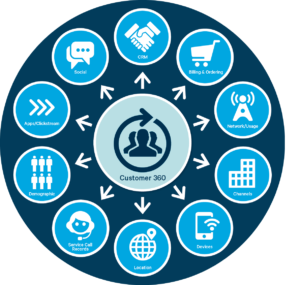
Meaningful Customer Experiences and Increased Revenue Start with Connected Data

(greenbutterfly/Shutterstock)
“I’m frustrated because we have all this data, but can’t get meaningful insights with it.”
Those were the words of a Fortune 100 CIO I recently talked with.
The first commandment, and core mission, of every (successful) company should be: “Know your customers.” But how do you do that? The answer lies in “listening” to customers via data and extracting meaningful insights from that data.
Graph analytics empowers every executive to uncover patterns, similarities and other insights hidden in their datasets that can result in more accurate business decisions. To get there, the process can be outlined in three overarching steps:: integrating data to make it reliable, building 360-degree views of this data and finally, extracting insights from the data to personalize recommendations for and deepen relationships with customers.
But first, some background and context…
According to market intelligence company IDC, the “Global Datasphere” in 2018 reached 18 zettabytes. (Yes, that’s zettabytes!) And the problem is only going to get worse — the amount of data being generated globally is increasing relentlessly.
The data being collected can, however, give a misleading or fragmented view of the real world, because the data is not linked to present a more comprehensive view. For example, a person could watch content on different devices, such as a smartphone, tablet device or desktop computer, from various streaming platforms, including Roku, XBox, and Xfinity, using multiple accounts in some cases, spanning HBO’s Go to Comcast’s Xfinity app, and so on. Although this will result in multiple data points, they are all associated with a single viewer.
Integrate Data to Draw Out New, Valuable Customer Insights
So, how do we derive meaningful information from all of this data? The answer: advanced analytics in graph, or advanced analytics in connected datasets (“graph” refers to connected data).
We need to link this data, analyze the relationships between these entities, and identify patterns in the links between them — all in real time — to extract maximum value.
Entity resolution helps with this challenge. Entity resolution is an important information integration problem: The same “real-world entities” (e.g. customers or products) are referred to in different ways in multiple data records. This is an essential data quality tool for, for example, businesses wanting to see the full customer journey and offer a contextually relevant next best action, or law enforcement agencies trying to uncover criminal activity and the perpetrators.
The key to entity resolution is connecting digital entities referring to the same real-world identities. Graph databases are the most intuitive and efficient data structures for connecting dots. Each digital entity can be represented as a vertex in the graph; each attribute that will be used to connect the entities can also be represented as a vertex in the graph. If we represent the entity-has-attribute relationship as edges, then we can form a graph where different entities are linked together when they share a set of attributes such as phone number, email, physical or IP address.
Build Complete, 360-Degree Views of Interconnected Data
The next step after resolving entities is to build 360-degree views of the data. Graph databases are the ideal way to accomplish this. Unlike traditional databases which store information such as name, demographics, browsing history, and purchasing in separate tables, graph databases link and analyze the relationships in the connected data. This results in a much better solution for understanding the connections among data.
A marketer could, for example, create a graph that identifies the names of the key people involved with a sales opportunity, along with their roles and the date of their involvement in the opportunity.
A couple of clicks identifies specific actions of the individuals involved in the opportunity, such as downloading a white paper, watching a webinar, attending a meeting, downloading developer edition software, signing up for a cloud-based trial and more. The dates of each of these actions are displayed on the graph. By applying analytics on this data, the marketer could now offer contextual next best actions to further move the customer along the sales campaign. I would much rather get a “people like you did this” rather than a generic, non-interesting recommendation that misses its mark.
The same concept applies to other industries. What about insurance companies being able to offer more contextually aware recommendations on the insurance you should be buying based on your age, life stage and so forth?
Personalize Customer Recommendations to Boost Customer Loyalty
Amazon estimates that 35% of its revenues come from cross-selling and up-selling. Businesses with a wide range of products or services have an opportunity to boost revenues by recommending complementary options to consumers. Purchases with recommendation clicks result in a 10% higher average order value and the per visit spend of a shopper who clicks a recommendation is five times higher.
Once an organization has developed 360-degree views of its customers, it has an opportunity to make product / service recommendations that have a higher probability of resonating with the target audience. Early recommendation engines, although breakthroughs at the time, simply looked at a couple of connected data points when making recommendations: A familiar scenario is People → who bought the Product ← which You just bought → also bought these other Products. Modern recommendation engines, by contrast, are able to traverse many data points to build a much richer understanding of a person’s likes and dislikes and, subsequently, provide recommendations which are much better informed. Businesses which are using these types of recommendation systems are able to drive 30% higher average order value.
An ability to offer increasingly personalized recommendations can be a significant competitive differentiator. According to one study, 73% of consumers prefer personalized shopping experiences. Moreover, relevant product recommendations help retailers build a deep relationship with their customers as they give them a sense of being understood and properly served.
The speed and volume of data has increased exponentially. This makes inference across networks and semantic relationships between entities a greater challenge to overcome in real time. Recommendation systems need to quickly understand the profile of their client, align that with the rapidly changing profiles of the larger customer base and product catalog, and produce engaging, personalized recommendations. Graph databases enable businesses to explore, analyze and understand the complex relationships in their data.
It takes two hops to find similar shoppers: Shopper → (Demographics) → Similar Shoppers and demographic-aware collaborative filtering can be implemented in five hops: Shopper → Products purchased → Other Shoppers who purchased the product → Demographics → Other Shoppers that belong to the Demographics → Other Products Purchased.
Oftentimes this requires an ability to go four or more levels deep into the data, across billions of orders and millions of customers, and do so rapidly, sometimes in fractions of a second. Although this is de rigueur for modern graph databases, it is beyond the ability of many.
The Result: Understand Your Customers, Drive Revenue in the Process
The better you know your audience, the more competitive your offering. Consider the example of a media company being able to link its businesses (e.g. programs, viewer preferences) to better understand its customers. This relationship analytics allows it to create a product that better offers their advertisers a hyper-personalized advertising platform to reach their desired audiences. To do so, the company had to build a database that links all of the particular preferences and attributes of a single consumer — in other words, “identity graph.” This has required using a graph database to perform deterministic and probabilistic entity resolution.
With the identity graph in place, the company is better able to help advertisers reach the right audiences with the appropriate promotional messages, resulting in more successful advertising campaigns for them, and higher profitability for the advertising business and its parent company.
Thus, integrating the right data can create better customer experiences, and a more differentiated offering.
Listen to Your Customers, Listen to the Data, Reap the Business Rewards
The digital era has given consumers unprecedented choices and simple recommendations such as “customers who bought this item also bought” or “these products are often bought together” are no longer enough. To drive customer delight and foster brand loyalty, businesses must gain a deep understanding of customers that includes knowledge of the unique, varied, and complex characteristics of everyone — and use this understanding to deliver, on the fly, offers and recommendations that truly speak to them. Businesses that take the time to “listen” to customers, analyze the data and act on meaningful data insights will gain the competitive advantage. And graph analytics is the enabling technology that provides businesses with this power to succeed in ways previously unimagined.
About the author: Todd Blaschka is the Chief Operating Officer at TigerGraph responsible for driving growth initiatives and scaling business operations. He is a technology industry veteran with nearly 20 years of sales leadership experience and a strong background in strategy and products. Prior to TigerGraph, Blaschka was vice president of worldwide sales at Clustrix, Inc. Additionally, he served as vice president of sales at Dataguise and has held various sales and marketing leadership positions at IBM, Electric Cloud and Sendmail, Inc., which was acquired by Proofpoint, Inc. in 2013.
Related Items:
Data is Cheap, Information is Expensive
The Bright Future of Semantic Graphs and Big Connected Data
Connected Assets, Big Data and Better Decision-Making




























